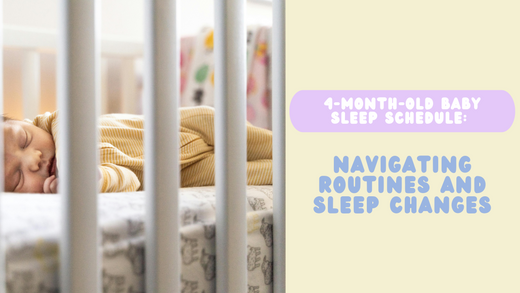
4-Month-Old Baby Sleep Schedule: Navigating Routines and Sleep Changes
Share
Your baby’s fourth month is an exciting time of growth and change, but it can also bring new challenges when it comes to sleep. In this guide, we’ll share a sample nap routine, tips for creating an ideal sleep environment, and guidance on handling the dreaded 4-month sleep regression. This is also a great time to consider using the Simple Parenting Sleep Training Plan to establish healthy sleep habits for your baby and the whole family.
Understanding Your 4-Month-Old’s Sleep Needs
At 4 months, your baby is developing a more mature circadian rhythm. This means their sleep is becoming more structured, but it also marks the start of the well-known 4-month sleep regression. During this period, your baby may wake more frequently at night or struggle with naps due to developmental changes. Establishing consistent routines and healthy sleep habits can help you navigate this transition smoothly.
Sample Nap Routine for a 4-Month-Old
Here’s a flexible nap schedule to guide your days:
- 7:00 AM: Awake and milk feed
- 9:00 AM: Nap (45–60 minutes)
- 10:00 AM: Awake
- 10:30 AM: Milk feed
- 12:00 PM: Nap (can offer a top-up milk feed around 11:30 AM if needed to encourage a long sleep)
- 2:00–2:15 PM: Awake and milk feed
- 4:00–4:30 PM: Nap (power nap)
- 5:00 PM: Awake and milk feed
- 5:30–5:45 PM: Bath
- 6:15–6:30 PM: Milk feed and wind-down routine
- 6:30–7:00 PM: Asleep in bassinet or crib
💡 Pro Tip: Feed your baby on demand overnight. It’s common for 4-month-olds to wake 1–3 times for milk feeds.
The 4-Month Sleep Regression: What to Expect
The 4-month sleep regression is a developmental milestone that typically occurs between 3–6 months of age. During this time, your baby’s sleep patterns mature, shifting to more adult-like sleep cycles. This transition is a sign of healthy development, but it can also bring challenges, such as:
- Increased night wakings
- Shorter or disrupted naps
- Difficulty settling back to sleep
As your baby begins cycling through light and deep stages of sleep, they may wake more frequently and struggle to link their sleep cycles independently. This is a skill they must relearn either through sleep training or over time.
While this period can feel overwhelming, it’s also a fantastic opportunity to establish consistent sleep habits. At 4 months, your baby is developmentally ready to start learning how to self-soothe and fall asleep independently. The Simple Parenting Sleep Training Plan provides step-by-step guidance to gently support your baby through this process, helping reduce night wakings, lengthen sleep stretches, and create a predictable routine for your family.
With patience, a calming sleep environment, and the right tools, you can help your baby navigate this transition and set the foundation for restful sleep in the months ahead.
How the Simple Parenting Sleep Training Plan Can Help
Our plan provides gentle, step-by-step instructions to teach your baby how to self-soothe and sleep independently. With methods tailored to your baby’s age and development, the plan can help you:
- Reduce night wakings
- Encourage longer, more restful sleep stretches
- Create a predictable sleep routine for your family
Learn more about the Simple Parenting Sleep Training Plan here.
Establishing nighttime sleep training is an essential first step before transitioning to nap training. While working on nighttime sleep, you can still follow this nap schedule to maintain consistency in your baby’s daily routine.
Sleep Environment Checklist
A calming sleep environment is crucial for restful sleep. Use this checklist to ensure your baby’s sleep space is set up for success:
- Dark room: Use blackout curtains to block out light.
- Consistent wind-down routine: Signal that it’s time to sleep.
- Dummy (pacifier): If your baby uses one.
- Sleeping Suit or Swaddle: Choose one suitable for the season. At this age, your baby may start to roll and you should immediately stop swaddling them for sleep when you see signs of this. You can use a transitional sleep suit like the Baby Merlin's Magic Sleepsuit or the SleepingBaby Zipadee-Zip Transitional Swaddle. Or you can use a standard sleep sack like the KYTE BABY Sleep Bag.
- White noise: Mimics the womb environment. A favorite is the Hatch Rest Baby Sound Machine.
- Cozy temperature: Keep the room at 68–72°F (20–22°C).
- Full tummy: Full babies tend to sleep better.
- Pre-sleep kisses and cuddles: A soothing connection before bed.
FAQs About 4-Month-Old Sleep
1. How do I handle frequent night wakings?
If you are not sleep training, respond to your baby’s needs with hands-on settling techniques like patting or rocking. If you’re ready to start sleep training, our plan provides effective strategies.
2. What should I do if naps are short?
Short naps are common during the 4-month regression. Stick to consistent nap times and focus on creating a soothing sleep environment.
3. Is it too early to sleep train?
No! Many parents find 4 months to be an ideal age to start sleep training. Use the Simple Parenting Sleep Training Plan to gently guide your baby toward better sleep habits. Each baby is different but the ideal time to sleep train is between 4 - 6 months of age.
Final Thoughts
The fourth month brings significant changes to your baby’s sleep, but with the right routines and tools, you can navigate this period with confidence. Whether you’re managing the 4-month sleep regression or starting sleep training, consistency and a calming sleep environment are key.
For more expert tips and step-by-step parenting guides, visit Simple Parenting Plans. We’re here to support you every step of the way.
Legal Disclaimer: The information in this blog is for educational purposes only and should not replace professional medical advice. Always consult your pediatrician for specific guidance regarding your child’s sleep. For more information, visit the CDC’s Safe Sleep Guidelines.
As an Amazon Associate, I earn from qualifying purchases. I only link to products that I truly believe in. This means I may earn a small commission when you click on links to Amazon products in this post, at no additional cost to you. Thank you for supporting Simple Parenting Plans!
